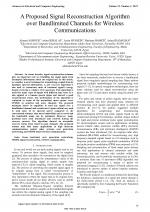| 1/2023 - 3 |
A Proposed Signal Reconstruction Algorithm over Bandlimited Channels for Wireless CommunicationsASHOUR, A. |
| Extra paper information in |
| Click to see author's profile in |
| Download PDF |
Author keywords
baseband, next generation networking, OFDM, signal reconstruction, wireless communication
References keywords
signal(18), reconstruction(10), processing(10), sampling(7), signals(6), theory(5), systems(5), transform(4), pulse(4), phase(4)
Blue keywords are present in both the references section and the paper title.
About this article
Date of Publication: 2023-02-28
Volume 23, Issue 1, Year 2023, On page(s): 19 - 32
ISSN: 1582-7445, e-ISSN: 1844-7600
Digital Object Identifier: 10.4316/AECE.2023.01003
Web of Science Accession Number: 000937345700003
SCOPUS ID: 85150222671
Abstract
In recent decades, signal reconstruction schemes play an important role in rebuilding the signal again from incomplete information about the original one. In this article, we consider a novel technique for transmitting a signal from its bandpass spectral information. A new recovery algorithm is also used to reconstruct most of baseband signals energy despite receiving a window of its spectrum. This algorithm is tested for many types of signals with different data rates. It is also applied to a human speech signal and showed a good reconstruction status. The performance of the algorithm is evaluated in terms of the normalized mean square error (NMSE) in noiseless and noisy channels. The proposed technique shows its capability to send any signal over a bandlimited channel and reconstruct it again without any need to send most of its spectral power compared to the conventional schemes, thus more bandwidths can be saved and the bandwidth usage can be optimized. However, many problems have been introduced and resolved during the recovery process. The algorithm showed an acceptable recovery status when tested in noisy channels. The proposed scheme may find many applications in high data-rate communications, pulsed radar systems, next generation networking, and OFDM-based wireless communication. |
| References | | | Cited By |
Web of Science® Times Cited: 3 [View]
View record in Web of Science® [View]
View Related Records® [View]
Updated 3 weeks, 6 days ago
SCOPUS® Times Cited: 3
View record in SCOPUS® [Free preview]
View citations in SCOPUS® [Free preview]
[1] A Spectrum Injection-Based Approach for Malware Prevention in UHF RFID Systems, Ashour, Ahmed F., Condie, Calvin, Pocock, Cade, Chiu, Steve C., Chrysler, Andrew, Fouda, Mostafa M., IEEE Access, ISSN 2169-3536, Issue , 2023.
Digital Object Identifier: 10.1109/ACCESS.2023.3313117 [CrossRef]
[2] A new result for synchronizing nonlinear discrete-time chaotic systems connected by bandlimited channels, Hamiche, Hamid, Megherbi, Ouerdia, International Journal of Dynamics and Control, ISSN 2195-268X, Issue 7, Volume 12, 2024.
Digital Object Identifier: 10.1007/s40435-023-01359-3 [CrossRef]
Disclaimer: All information displayed above was retrieved by using remote connections to respective databases. For the best user experience, we update all data by using background processes, and use caches in order to reduce the load on the servers we retrieve the information from. As we have no control on the availability of the database servers and sometimes the Internet connectivity may be affected, we do not guarantee the information is correct or complete. For the most accurate data, please always consult the database sites directly. Some external links require authentication or an institutional subscription.
Web of Science® is a registered trademark of Clarivate Analytics, Scopus® is a registered trademark of Elsevier B.V., other product names, company names, brand names, trademarks and logos are the property of their respective owners.
Faculty of Electrical Engineering and Computer Science
Stefan cel Mare University of Suceava, Romania
All rights reserved: Advances in Electrical and Computer Engineering is a registered trademark of the Stefan cel Mare University of Suceava. No part of this publication may be reproduced, stored in a retrieval system, photocopied, recorded or archived, without the written permission from the Editor. When authors submit their papers for publication, they agree that the copyright for their article be transferred to the Faculty of Electrical Engineering and Computer Science, Stefan cel Mare University of Suceava, Romania, if and only if the articles are accepted for publication. The copyright covers the exclusive rights to reproduce and distribute the article, including reprints and translations.
Permission for other use: The copyright owner's consent does not extend to copying for general distribution, for promotion, for creating new works, or for resale. Specific written permission must be obtained from the Editor for such copying. Direct linking to files hosted on this website is strictly prohibited.
Disclaimer: Whilst every effort is made by the publishers and editorial board to see that no inaccurate or misleading data, opinions or statements appear in this journal, they wish to make it clear that all information and opinions formulated in the articles, as well as linguistic accuracy, are the sole responsibility of the author.



